

Marine turtles, together with some representatives of other orders, are the only still-living reptiles which have adjusted themselves to the marine environment: in fact they depend on the land only in the reproductive period, when the female turtles go up the beaches to lay their eggs in the sand.
To succeed in living in an environment as the marine one, these animals have undergone
important anatomical, physiological and ecological changes: They have modified their
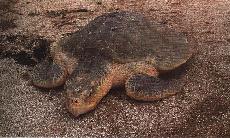 locomotive apparatus, the structure of the carapace, some internal organs, their type of nutrition
and their behavior in general.
Nonetheless turtles have kept unaltered some basic characteristics peculiar to reptiles: in the first
place the ectothermy, or the dependence of the internal temperature on that of the environment;
air breathing which compels these animals to surface frequently; the scale-covered body; and,
lastly the system of egg-laying, which consists in the release of eggs in holes dug in the ground.
On the other hand, the limbs have undergone notable changes in the transition from terrestrial
to aquatic life.
locomotive apparatus, the structure of the carapace, some internal organs, their type of nutrition
and their behavior in general.
Nonetheless turtles have kept unaltered some basic characteristics peculiar to reptiles: in the first
place the ectothermy, or the dependence of the internal temperature on that of the environment;
air breathing which compels these animals to surface frequently; the scale-covered body; and,
lastly the system of egg-laying, which consists in the release of eggs in holes dug in the ground.
On the other hand, the limbs have undergone notable changes in the transition from terrestrial
to aquatic life.
The different kind of locomotion in a liquid required a new and different conformation: the front limbs have come to look like blades, which are able to move large quantities of water and enable these animals to move at a sustained velocity. The flippers, which are particularly flattened and elongated, are used simultaneously for propulsion; whereas the hind limbs which are shorter and stockier, act as a rudder.
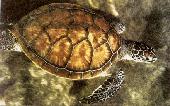 One of the most distinctive characteristics of marine turtles is the shell, a strong structure
covering almost entirely the body and all the organs of the animal. The shell consists of an upper
part (carapace), which is more or less convex, and a lower part (plastron), which is generally flat,
joined by elastic ligaments. Both are made up of two different layers: the external one is formed
of horny scutes - the arrangement of which can be utilized to distinguish the different species
and covers a deeper layer, which is made up of a series of flattened bones fused together. The
components of these layers do not coincide in number or in shape; as a matter of fact every scute
usually tends to overlap the point between two bones beneath, in order to give greater sturdiness
to the carapace.
One of the most distinctive characteristics of marine turtles is the shell, a strong structure
covering almost entirely the body and all the organs of the animal. The shell consists of an upper
part (carapace), which is more or less convex, and a lower part (plastron), which is generally flat,
joined by elastic ligaments. Both are made up of two different layers: the external one is formed
of horny scutes - the arrangement of which can be utilized to distinguish the different species
and covers a deeper layer, which is made up of a series of flattened bones fused together. The
components of these layers do not coincide in number or in shape; as a matter of fact every scute
usually tends to overlap the point between two bones beneath, in order to give greater sturdiness
to the carapace.
As for the geographical distribution, marine turtles are animals which live mostly in tropical and subtropical zones. Though they spend most of their time into the sea, the female turtles have strong ties with the beach for egg-laying. The males stay in the water all their life, though it may happen that specimens of some populations come out on the land for thermoregulation.
Temperature is one of the main elements which affect the life of turtles. The temperature of the
sand influences the development of eggs and the sex of the offsprings. The temperature of water
influences mating, the maturing of the eggs in the female turtles and the movements (whether
full-scale migrations or less) of both the adults and the young.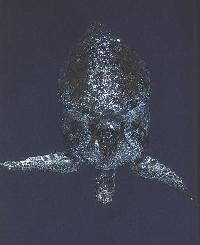 During the reproductive period adult turtles tend to migrate from foraging to nesting areas where
females and males usually court and mate. Eggs take around 20 days to be produced, fecundated
and mature. In the last days the female turtles approach the beach, where the laying of eggs will
take place, spending their days in warmer water, then leave the water to make the nest.
During the reproductive period adult turtles tend to migrate from foraging to nesting areas where
females and males usually court and mate. Eggs take around 20 days to be produced, fecundated
and mature. In the last days the female turtles approach the beach, where the laying of eggs will
take place, spending their days in warmer water, then leave the water to make the nest.
Almost all of the marine turtles species build the nest during summer and at night. The female turtle emerges from the surf and, lifting her head and alert for danger, rests in the wash zone on the beach. Having checked the state of the beach, the female slowly drags herself along to a certain distance from the water, which usually corresponds to a point which the high tide does not reach. Once she has found the ideal place to lay the eggs, the female begins to build the nest. First the hole is dug by the fore flippers, which in about ten minutes form a hollow in the dry sand, a little bigger than the turtle and called a "body pit"; then the hind flippers work in turns to remove the moist sand. At the end of the digging operations, a hollow from, 40 to 50 centimeters deep resembling a flask is obtained; it is called an "egg chamber".
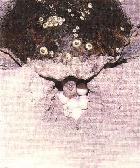 Now the female is ready to lay about hundred of eggs in the hole, which has been just dug,
though it is not impossible to find nests with these small spheres, which, in shape, size and color
are similar to table-tennis balls. Once she has finished laying eggs, the turtle carefully fills in the
hollow, using the hind flippers again; then partly wipes out traces of the nest by throwing up a
large quantity of dry sand with the fore flippers. Then she returns to the sea.
Now the female is ready to lay about hundred of eggs in the hole, which has been just dug,
though it is not impossible to find nests with these small spheres, which, in shape, size and color
are similar to table-tennis balls. Once she has finished laying eggs, the turtle carefully fills in the
hollow, using the hind flippers again; then partly wipes out traces of the nest by throwing up a
large quantity of dry sand with the fore flippers. Then she returns to the sea.
The females nest from 1 to 4 times in a season (though exceptionally up to seven times have been described) at intervals that vary from 10 to 20 days. The eggs left in the nest are naturally incubated by the warmth that the sun imparts to the sand. It has been verified that in all turtles the temperature is the determining factor in deciding the sex of the hatchlings. Every single species has a precise threshold temperature (about 30oC); eggs which are hatched at temperatures inferior to the threshold produce mainly males, while the other sex prevails in those eggs which are exposed to higher temperatures.
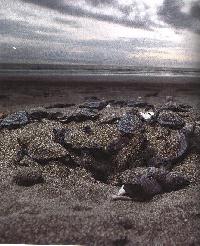 After an average period of from 50 to 70 days from laying, the new born turtles break the shell
using a particular structure, the "egg tooth", which will disappear after a couple of weeks. Not
all the eggs will hatch at the same time and some of them will not develop at all.
As soon as the offspring emerge from the shell, they begin to move towards the surface. This can
also happen in small groups and at intervals from two to ten days.
Because of their characteristic attraction to the light, the young turtles immediately make for
towards the more illuminated zone, which should correspond to the sea. Therefore headlights
and street-lamps can often cause these animals to lose their bearings. For these reptiles the trip
from the nest to the sea is one of the most dangerous because they are an easy prey for predatory
animals. Those which manage to reach the water immediately begin to swim towards the open
sea. At this point information about the life of these reptiles begins to become more and more
vague. It is known that for a certain period they swim close to the surface, feeding prevalently
on small invertebrates, probably letting themselves drift with the sea currents. This period of
their life has been defined as "the lost year". Only after some years they will approach the shore
again. After many years from birth (10/50 years according to scientists) turtles come to sexual
maturity and the females are able to mate and to lay eggs seemingly to the same beaches on
which they were hatched.
After an average period of from 50 to 70 days from laying, the new born turtles break the shell
using a particular structure, the "egg tooth", which will disappear after a couple of weeks. Not
all the eggs will hatch at the same time and some of them will not develop at all.
As soon as the offspring emerge from the shell, they begin to move towards the surface. This can
also happen in small groups and at intervals from two to ten days.
Because of their characteristic attraction to the light, the young turtles immediately make for
towards the more illuminated zone, which should correspond to the sea. Therefore headlights
and street-lamps can often cause these animals to lose their bearings. For these reptiles the trip
from the nest to the sea is one of the most dangerous because they are an easy prey for predatory
animals. Those which manage to reach the water immediately begin to swim towards the open
sea. At this point information about the life of these reptiles begins to become more and more
vague. It is known that for a certain period they swim close to the surface, feeding prevalently
on small invertebrates, probably letting themselves drift with the sea currents. This period of
their life has been defined as "the lost year". Only after some years they will approach the shore
again. After many years from birth (10/50 years according to scientists) turtles come to sexual
maturity and the females are able to mate and to lay eggs seemingly to the same beaches on
which they were hatched.
 Turtles, especially young specimens, easily fall prey to predatory animals. Eggs hidden in the
sand can be immediately destroyed by jackals, dogs, foxes and pigs. Eggs are not safe either
from infections caused by bacteria or fungi. When the survivors surface to head for the sea, they
have to deal with other kind of predators no less dangerous than the former. Among these can
be found several
small and medium sized mammals, crustaceans and many kinds of birds. At the sea the hunt
continues both on the surface of the water, on the path of birds, and under it because of the
presence of predatory fish. At the youth stage the hunt tends to diminish, though continues with
fish and sharks in particular. At the adult stage these marine reptiles theoretically can live almost
undisturbed. The only predators are sharks (sometimes killer whales) and man. The last
mentioned is by far the worst enemy: by the indiscriminate use of resources; he can provoke the
extinction of these species in a very short time.
Turtles, especially young specimens, easily fall prey to predatory animals. Eggs hidden in the
sand can be immediately destroyed by jackals, dogs, foxes and pigs. Eggs are not safe either
from infections caused by bacteria or fungi. When the survivors surface to head for the sea, they
have to deal with other kind of predators no less dangerous than the former. Among these can
be found several
small and medium sized mammals, crustaceans and many kinds of birds. At the sea the hunt
continues both on the surface of the water, on the path of birds, and under it because of the
presence of predatory fish. At the youth stage the hunt tends to diminish, though continues with
fish and sharks in particular. At the adult stage these marine reptiles theoretically can live almost
undisturbed. The only predators are sharks (sometimes killer whales) and man. The last
mentioned is by far the worst enemy: by the indiscriminate use of resources; he can provoke the
extinction of these species in a very short time.
